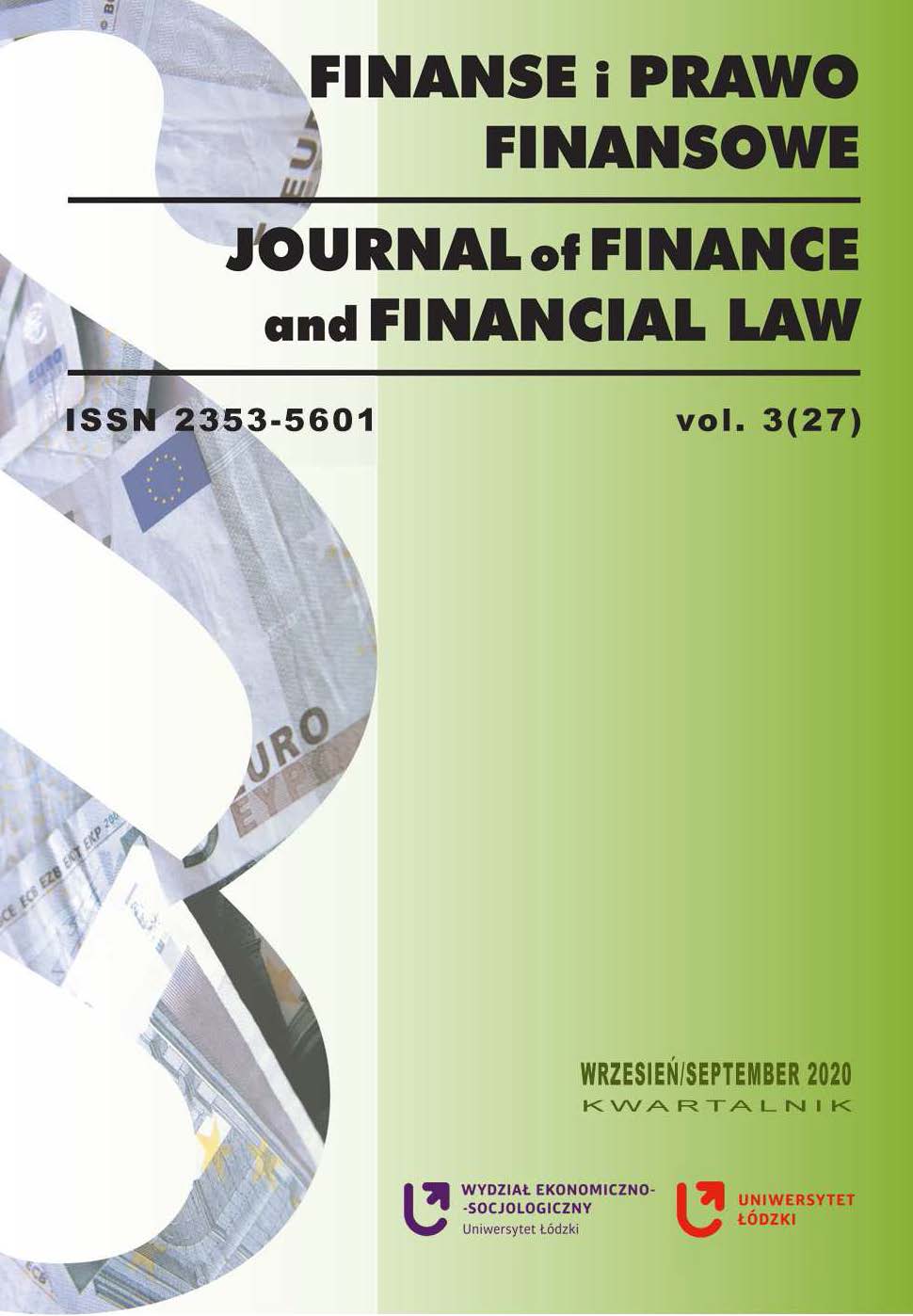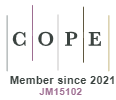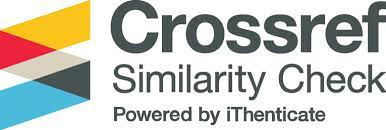The Essence and Significance of Financial Instruments for Enterprises in Poland in 2010-2018
DOI:
https://doi.org/10.18778/2391-6478.3.27.06Keywords:
financial instruments, non-financial enterprises, financial resultsAbstract
The purpose of the article/hypothesis: The aim of the study is an attempt to show the degree of use of financial instruments by non-financial enterprises operating on the Polish market and to determine whether their application translates into the financial results achieved by these enterprises. The hypothesis was adopted that the importance and use of financial instruments by enterprises on the Polish market is not significant, however, as a result of global transformations and the growing importance of financial markets, the activity of entities in this respect will increase.
Methodology: In order to determine the degree of use of financial instruments among enterprises, the data published by the Central Statistical Office (GUS) for the years 2010–2018 were used and the key indicators illustrating the involvement of enterprises in the instruments available on the financial market were calculated. The literature on the subject was also reviewed and analyzed.
Results of the research: The conducted considerations that non-financial enterprises in the polish market showed an increase in involvement in financial activities, as evidenced by the growing share of financial instruments, both on the active and passive side. On the passive side, the use of credits and loans in financing the activities of entities increased. This increase, however, did not translate into the use of the effects of financial leverage in the surveyed enterprises and an increase in the profitability of equity. In the case of assets, in the analyzed period there was an increase in the involvement of free funds in investments, mainly due to an increase in equity financial instruments. However, the analysis of financial revenues in total revenues may suggest that greater involvement in the financial sphere does not translate into profitability of assets and the results of the surveyed entities. It should be emphasized, however, that the development of the financial market and the increasing availability and variety of financial instruments strengthen the interest of enterprises in capital investments.
Downloads
References
Antkiewicz S., 2012, Papiery wartościowe na rynku pieniężnym i kapitałowym, CeDeWu, Warszawa.
Google Scholar
Crotty J., 2005, The Neoliberal Paradox: The Impact of Destructive Product Market 5 Competition and Modern Financial Markets on Nonfinancial Corporation Performance in 6 the Neoliberal Era, [in:] G.A. Epstein (ed.), Financialization and the World Economy, Edward Elgar Publishing, 7 Northampton.
Google Scholar
Dembinski P.H., 2011, Finanse po zawale. Od euforii finansowej do gospodarczego ładu, tłum. Ł. Komuda, Studio Emka, Warszawa.
Google Scholar
Directive 2004/39/EC of the European Parliament and of the Council of 21 April 2004 on markets in financial instruments amending Council Directives 85/611 / EEC and 93/6 / EEC and Directive 2000/12 / EC of the European Parliament and of the Council and repealing Directive Council 93/22 / EEC.
Google Scholar
European Commission, 2015, Green Paper: Building a Capital Markets Union, COM (2015) 63 final.
Google Scholar
Głuchowski J., 2001, Leksykon finansów, PWE, Warszawa.
Google Scholar
Gomuła W., 2018, Sprawność gospodarcza i produktywność w czasach finansjalizacji, [w:] S. Lis, K. Zieliński (red.), Ekonomia Przyszłości. Państwo Efektywne Czy Sprawiedliwe?, Uniwersytet Ekonomiczny w Krakowie.
Google Scholar
GUS, 2011, Instrumenty finansowe przedsiębiorstw niefinansowych w 2010 roku, http://stat.gov.pl/ [access 20.04.2020].
Google Scholar
GUS, 2012, Instrumenty finansowe przedsiębiorstw niefinansowych w 2011 roku, http://stat.gov.pl/ [access 20.04.2020].
Google Scholar
GUS, 2013, Instrumenty finansowe przedsiębiorstw niefinansowych w 2012 roku, http://stat.gov.pl/ [access 20.04.2020].
Google Scholar
GUS, 2014, Instrumenty finansowe przedsiębiorstw niefinansowych w 2013 roku, http://stat.gov.pl/ [access 20.04.2020].
Google Scholar
GUS, 2015, Instrumenty finansowe przedsiębiorstw niefinansowych w 2014 roku, http://stat.gov.pl/ [access 20.04.2020].
Google Scholar
GUS, 2016, Instrumenty finansowe przedsiębiorstw niefinansowych w 2015 roku, http://stat.gov.pl/ [access 20.04.2020].
Google Scholar
GUS, 2017, Instrumenty finansowe przedsiębiorstw niefinansowych w 2016 roku, http://stat.gov.pl/ [access 20.04.2020].
Google Scholar
GUS, 2018, Instrumenty finansowe przedsiębiorstw niefinansowych w 2017 roku, http://stat.gov.pl [access 20.04.2020].
Google Scholar
GUS, 2019, Instrumenty finansowe przedsiębiorstw niefinansowych w 2018 roku, http://stat.gov.pl/ [access 20.04.2020].
Google Scholar
Jajuga K., Jajuga T., 2015, Inwestycje. Instrumenty finansowe. Aktywa niefinansowe. Ryzyko finansowe. Inżynieria finansowa, Wydawnictwo Naukowe PWN, Warszawa.
Google Scholar
DOI: https://doi.org/10.18276/frfu.2015.75-15
Knipper G.R., 2005, Finanzalization of the American Economy, „Socio-Economic Review”, vol. 3, May.
Google Scholar
DOI: https://doi.org/10.1093/SER/mwi008
IAS 32, https://eur-lex.europa.eu/legal_content/PL/TXT/PDF/?uri=CELEX:32004R2086&from=PL [access 30.04.2020].
Google Scholar
Lemmonier M., 2011, Europejskie modele instrumentów finansowych. Zagadnienia wybrane, Warszawa.
Google Scholar
Milberg W., 2008, Shifting sources and uses of profits: sustaining US financialization with global value chains, „Economy and Society”, vol. 37(3).
Google Scholar
DOI: https://doi.org/10.1080/03085140802172706
Owsiak S., 2002, Podstawy nauki finansów, PWE, Warszawa.
Google Scholar
Polański Z., 2008, Wprowadzenie. System finansowy we współczesnej gospodarce rynkowej, [w:] B. Pietrzak, Z. Polański, B. Wożniak (red.), System finansowy w Polsce, t. I, Warszawa.
Google Scholar
Pietrzak B., Polański Z., Woźniak B., 2008, System finansowy w Polsce, Wydawnictwo Naukowe PWN, Warszawa.
Google Scholar
Rozporządzenie Ministra Finansów z dnia 27 lutego 2004 r. w sprawie szczegółowych zasad uznawania, metod wyceny, zakresu ujawniania i sposobu prezentacji instrumentów finansowych, Dz.U. nr 31, poz. 266.
Google Scholar
Rydzewska A., 2018, Zarządzanie wartością przedsiębiorstw niefinansowych w obliczu procesów finansjalizacji, „Zarządzanie i Finanse”, r. 16, nr. 4, cz.1. ss. 179–192.
Google Scholar
Sokół H., 2017, Krótkoterminowe papiery dłużne w zarządzaniu płynnością przedsiębiorstwa, [w:] A. Fierla (red.), Finansjeryzacja gospodarki i jej wpływ na przedsiębiorstwa, Oficyna Wydawnicza SGH, Warszawa.
Google Scholar
Szczepankowski P., 2018, Znaczenie unii rynków kapitałowych dla rozwoju alternatywnych źródeł finansowania małych i średnich przedsiębiorstw w Unii Europejskiej, „Studia BAS”, nr 1(53), ss. 45–75.
Google Scholar
Ustawa z dnia 29 lipca 2005 r. o obrocie instrumentami finansowymi, Dz.U. 2005, nr 183, poz. 1538.
Google Scholar
Ustawa z dnia 29 września 1994 r. o rachunkowości, Dz.U. 1994, nr 121, poz. 591.
Google Scholar
Veron N., Wolff G.B., 2016, Capital Markets Union: A Vision for the Long term, Journal of Financia Regulation, vol. 2, issue 1, ss. 130–153.
Google Scholar
DOI: https://doi.org/10.1093/jfr/fjw006
Waliszewski K., 2017, Europejska unia rynków kapitałowych – szanse i zagrożenia realizacji w Polsce, „Studia Oeconomica Posnaniensia”, vol. 5, no. 8, ss. 51–67.
Google Scholar
DOI: https://doi.org/10.18559/SOEP.2017.8.4
Wypych M., 2002, Rentowność inwestycji finansowych w przedsiębiorstwie, „Acta Universitatis Lodziensis. Folia Oeconomica”, nr 161, ss. 183–203.
Google Scholar
Downloads
Published
How to Cite
Issue
Section
License

This work is licensed under a Creative Commons Attribution-NonCommercial-NoDerivatives 4.0 International License.














